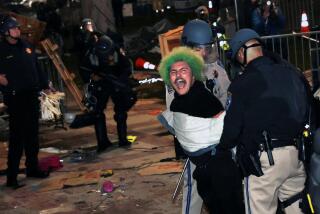Must Demonstrators Be Shot? : Law: International guidelines are being drawn to help authorities control outbreaks of domestic political violence without excessive force.
One year ago, the Tian An Men massacre offered the most brutal evidence of how incompetent and clumsy one government could be when confronted with a mass political demonstration. But the Chinese have not been alone in their bloody crowd-control tactics. In the past 18 months, government troops and police also used lethal force against civilian protesters in Soviet Georgia, Czechoslovakia, East Germany, Romania, the West Bank, Soviet Azerbaijan, Kashmir, the Serbian province of Kosovo, Soviet Tadzhikistan, Haiti, South Africa, Nepal and South Korea.
While international law has been invoked in conflicts between nations, it is woefully inadequate at restraining governments under siege from opening fire on their own citizens. Finally, some international guidelines are being drawn.
A special congress of the United Nations will be convened this summer in Havana to approve some basic international principles on the use of force and firearms by law-enforcement officials. The principles should guide governments in the drafting of laws and, at a minimum, influence state authorities to follow more civilized rules of conduct.
In some of these conflicts, especially where ethnic and nationalist issues dominate, the protesters also have used weapons. The hard cases, where peaceful demonstrators mix with armed protesters, present excruciating dilemmas for law-enforcement officials, many of whom have little training in crowd control or urban guerrilla warfare.
For example, combat-trained Soviet troops sent to Azerbaijan had to fight a guerrilla war with local militia and contain unarmed civilian protesters. Where there are orders to shoot on sight, as the Indian army received in Kashmir, then the line can be easily crossed from crowd control to indiscriminate killings.
The obvious atrocities, such as the government-ordered massacre in Beijing, beg for unequivocal condemnation under international law. But archaic claims that domestic order is the internal affair of a sovereign nation have stymied efforts to regulate, or even condemn, such use of force.
Although the Universal Declaration of Human Rights and the International Covenant on Civil and Political Rights endorse the right to participate in lawful and peaceful assemblies, there is scant international law to guide officials on crowd-control methods so as to minimize the use of armed force against political demonstrators and even armed protesters.
There is a hefty, albeit controversial, code of conduct by which to judge conflicts between nations. And Protocol II of the 1949 Geneva Convention protects the rights of combatants and civilians engulfed in traditional civil wars, but not those who are caught up in internal disturbances. The Genocide Convention and the Helsinki Final Act of 1975 remain only partial fixes.
Among the new U.N. guidelines would be a restraint on the use of firearms except in self-defense or in the defense of others where there is an immediate threat of death or serious injury. When confronting unlawful but nonviolent assemblies, police and army troops would have to avoid the use of force or, where that becomes impracticable, could use only minimum force to break up the crowd.
In dispersing violent assemblies, law- enforcement officials could use firearms for defensive purposes only when less dangerous means fail. Violent demonstrators would be entitled to receive a clear warning of the intent to open fire and then given enough time to withdraw.
The basic principles also encourage governments to develop a broad range of crowd-control methods and to obtain non-lethal incapacitating weapons to minimize deaths and injuries. European countries may push in Havana for a prohibition on the use of firearms against children and, to the extent possible, juveniles and women. Exceptional circumstances, such as internal political instability or any other public emergency, could not be invoked to depart from any of the basic principles.
The influence of these non-binding principles on law-making bodies should not be underestimated. These principles on use of force should prove popular with representative governments, especially those emerging in Eastern Europe and the Soviet Union. Regional governments rarely have the opportunity to implement principles of international law in their local codes.
But the Bush Administration appears unlikely to participate in the conference because of Cuba’s deplorable human-rights record. Despite the ironic notion that such worthwhile principles will be debated and approved in uniquely repressive surroundings, the Administration will be abdicating the moral high ground if it stays home.
The United States and all democratic governments should be present in Havana to legislate the very principles that some day could help save the lives of people demonstrating for their freedom, especially in Cuba.
More to Read
Sign up for Essential California
The most important California stories and recommendations in your inbox every morning.
You may occasionally receive promotional content from the Los Angeles Times.










